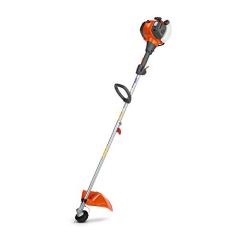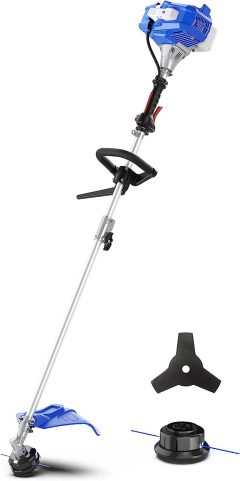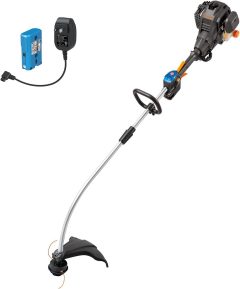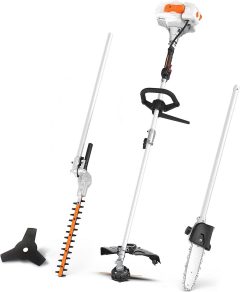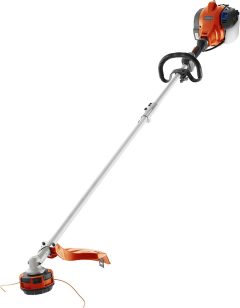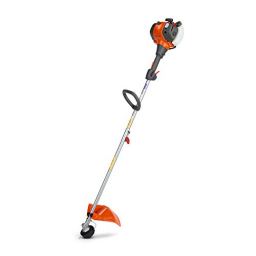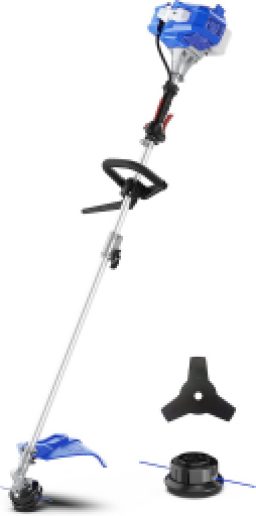Buying guide for best gas weed eaters
The secret to achieving an award-winning lawn is in the details. Crisply defined edges; no stray weeds congregating around flower beds, trees, yard ornaments, or sewer vents; and no undesirable scruffiness spilling out from beneath your fence. Keeping your green pristine is what makes your neighbors take notice and compliment you on your landscaping expertise. The tool that can best accomplish these many tasks is a gasoline-powered weed eater, also called a Weedwacker or trimmer.
There are many design and feature options that you will need to consider in order to discover which gas weed eater is best suited for your needs.
Fortunately, BestReviews is here to explain the differences and provide you with the advantages and disadvantages of each type in this shopping guide.
When you’re ready to buy, jump back to the top of the page to see which gas weed eaters we've determined are the best.
Types of gas weed eaters
Your gas weed eater is not only one of the most versatile tools in your outdoor power equipment arsenal but it is also one of the easiest to use. And this mighty tool can solve a multitude of yard maintenance problems. Essentially, it's a lawn mower that you can hold in your hands. The engine whirls a monofilament string round and round with sufficient velocity to slice through grass and weeds, trimming away the chaff until your property is the cream of the crop.
Shaft
The most noticeable difference between gas weed eaters is the shape of the shaft: one is long and straight while the other is somewhat shorter with a curved end. But what exactly does the form have to do with the function? Here are the pros and cons of each.
Curved shaft gas weed eater
Shorter
Lighter
Easier for less experienced user to manipulate
Easier to reach tight or awkward spaces
Designed for consumer use (light duty)
Less durable (Because the cable that drives the machine travels along a curved shaft, there’s greater wear and tear on that cable.)
Less comfortable for taller people to use
Straight shaft gas weed eater
Adjustable shaft gas weed eater
Engine
The engine on a gas weed eater is located at the top of the shaft. When you pull the starter rope, it sets the piston in motion. In a two-stroke engine, the piston fires (produces power) every time it completes a revolution. In a four-stroke engine, it takes two revolutions to make the piston fire. This means that a two-stroke engine has the potential to produce twice as much power as a four-stroke engine. But there is a little more to the science – and some pros and cons.
Two-stroke engine: In a two-stroke engine, the oil and fuel are mixed together in the fuel tank. Some of the fuel mixture is expelled before being used, and since the piston fires twice as often, the gas burns up much faster in this type of engine.
Pros:
No valves
Lighter
Costs less to make
More powerful
Cons:
Wears out faster (higher rpm)
No oil reserve dedicated to lubricating parts
Less environmentally friendly to the environment
Costs more for oil
Less fuel efficient
Four-stroke engine: In a four-stroke engine, the oil and the fuel are in separate reserves, so there is no oil burning. These engines only fire with every other rotation.
Pros:
Cons:
More parts
Heavier
Costs more to make
Less powerful
Did you know?
Your gas weed eater can effortlessly trim grass and clear away weeds. Just don't forget that the same tool can damage sensitive bark and mar wood structures like fencing or decks.
STAFF
BestReviews
Parts of a gas weed eater
Now it's time to learn a little more about the other parts that make your gas weed eater do what it does. Your particular gas weed eater should have most if not all of these items. Bear in mind that the names of these parts may vary from brand to brand.
Cutting guard
This shield attaches to the bottom of the gas weed eater and helps keep the machine from throwing debris at the user. It also prevents you from accidentally coming in contact with the cutting attachment.
Throttle lock
The throttle lock is a feature that, as the name suggests, allows you to lock the trigger into place. If your weed eater has a throttle lock, you won't have to tire your fingers out by holding it continuously. To disengage the throttle lock, you simply give the trigger a squeeze.
Throttle
This variable switch allows the user to increase or decrease the gas weed eater's power. It functions like the gas pedal in your car.
Choke
The choke allows you to restrict or "choke" the airflow into the carburetor in order to enrich the fuel-air mixture to facilitate the starting of a cold engine.
Primer bulb
When pressed and released, this bubble-like feature creates a vacuum that pulls fuel into the carburetor to make starting easier.
Starter rope handle
This is attached to the starter rope and is what you pull to get the crank shaft spinning to start the engine.
Air filter
Every engine needs oxygen to run. This foam-like insert keeps unwanted particles, dirt, and debris from entering your engine. It’s essential to keep this item clean so your gas weed eater runs at optimum levels.
Spark plug
This device converts the electric current to the tiny spark that causes the fuel to combust, driving the piston down to power your gas weed eater.
Muffler
The muffler reduces the noise from the engine and directs potentially dangerous exhaust gases away from the user.
Spark arrestor
This special mesh found in the muffler keeps dangerous sparks from igniting nearby combustible items. It’s important to regularly make sure the mesh is clean and undamaged.
Stop switch
A button that the user can press and hold to immediately shut off or disable the gas weed eater.
String
There is a wide variety of trimmer line for your gas weed eater. Most trimmer string is made of nylon, although there are some more durable varieties. Each type of string is designed for a fairly specific situation.
Thickness: The rule of thumb is the tougher the job, the thicker the line.
Use 0.065 inches or 0.080 inches for lightweight work like trimming grass.
Use 0.085 inches to 0.105 inches for weeds or thicker patches of grass.
Use 0.110 inches or 0.155 inches for really tough underbrush.
Shape: The shape of the line determines how effectively it cuts. (Think of the difference between a butter knife and a steak knife.)
Round: no edge; designed for light-duty work; tears rather than cuts.
Multi-sided: comes in many different shapes (square, star, pentagon); cleaner cut; good for thicker weeds.
Serrated: has teeth; good for thicker weeds and leaves.
Twisted: ideal for really tough or big jobs, thick weeds, underbrush; most durable.
Precut: If you’ve upgraded your gas weed eater's head to accommodate precut trimmer line, these short pieces of nylon are exactly what you'll need. This option offers tremendous cutting power and durability, but it requires a special trimmer head.
Blades
If you have tough brush that your nylon string can’t handle, you can try nylon blades. You'll need to purchase a head specifically designed to accept nylon trimmer blades.
Feed head
Because trimmer line wears out rather quickly and breaking is normal (and necessary when you accidentally clip something unyielding), you also need to choose the way the line feeds out.
Automatic feed head: The trimmer line is automatically advanced as needed by centrifugal force. The downside to this system is that you have little control over how much line is fed out, and you could go through the line more quickly than desired.
Bump feed head: You simply tap or "bump" the gas weed eater on the ground to release more line. It takes practice to learn to bump with the right amount of force and not damage the weed eater.
- Fixed-line head: This type of head uses precut line. When you need more line, you replace it with another precut piece.
Gas weed eater prices
Gas weed eaters range in price from $85 to $500. With such a wide variety of options and features available on these machines, you must carefully consider what you’re willing to spend versus what bells and whistles you want in order to find true value.
You can spend as little as $85 for a bargain brand, light-use consumer model.
You will find most mid-range models offer a good balance of cost, quality, and useful features.
You will pay up to $500 for a high-end, heavy-duty commercial grade model.
Tips
Never start or use a gasoline-powered weed eater in an enclosed space.
For the best cut, keep the trimmer head level and parallel with the ground.
When trimming, hold the head at a slight angle – it’s the end of the trimmer line that does the cutting – and proceed slowly. Let the trimmer do the work.
Trim to the same level as the cut lawn so there's no distinction in height.
For tall grass or weeds, cut in several passes, starting at the top.
Since most gas weed eaters spin counterclockwise, it’s most efficient to work from right to left.
FAQ
Q. What happens if I forget to mix oil with the fuel on my two-stroke engine?
A. The oil you add to the fuel is the only thing that lubricates your gas weed eater. Not adding oil, or not adding enough to create the proper ratio (as called for in your owner's manual), will cause the engine to seize.
Q. How do I clean my gas weed eater?
A. After shutting off your weed eater, let it cool for a few minutes. Then, before putting it away, simply brush the clippings and debris off the unit.
Q. Where is the best place to store my gas weed eater?
A. The best place is cool and dry and either locked or out of reach of children. If you will be putting it away for more than three months, be sure to add fuel stabilizer to the gasoline so it doesn't ruin your carburetor.


